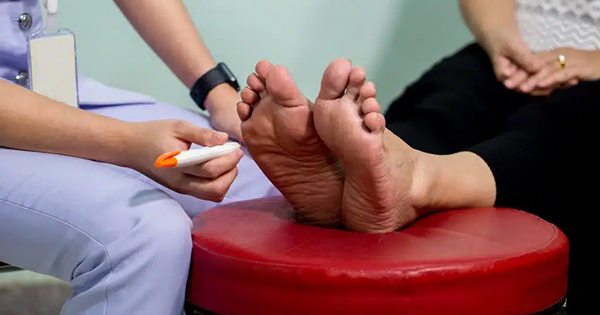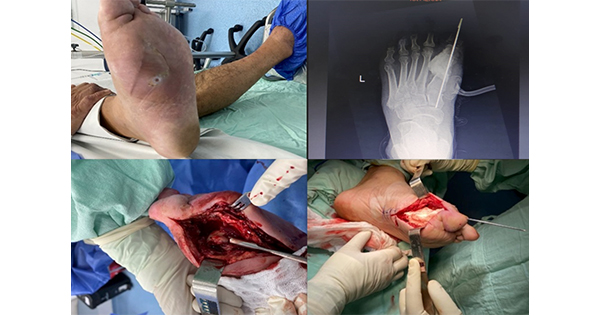The estimated prevalence of diabetes in the UK is 3.7 million people with 10% of this population experiencing secondary complications of the foot (Diabetes UK, 2017). Foot ulcers that arise from diabetes have a significant financial impact on the NHS due to community care services, outpatient costs, and increased hospital bed occupancy. It is estimated that around £1 billion of NHS expenditure (which equates to approximately £1 for every £140 spent) is used for the management of diabetic foot ulcers (DFUs) or lower-limb amputations per annum (Kerr, 2017).
Specific guidelines for the prevention and management of foot disease, including DFUs were published by the National Institute for Health and Care excellence (NICE, 2016). These recommendations state that standard care should address control of wound infection, control of ischaemia, wound debridement, wound dressings and ‘wound offloading.’
In clinical practice, patients with DFUs are advised to limit standing and walking to enable the foot to rest for optimal wound healing advocated by the International Working Group of the Diabetic Foot (2015). The guidelines also recommend the use of an offloading device e.g. below-knee casting, walkers, footwear or insoles. When patients are advised to rest this may be confusing, as it appears to contradict other health messages about the value of exercise, particularly for people with diabetes for better blood sugar control and to reduce the risk of cardiovascular diseases.
Clearly, the relative benefits and risks of exercise for health and functioning can only be evaluated reliably if considered with other personal and environmental factors (World Health Organization, 2001). Confusion may increase, if patients are given different advice at different time points, in different settings or by different healthcare professionals. Patients are asked to follow dietary advice, monitor their activity, often alongside controlling other variables; it is understandable, therefore, that some struggle to reduce activity levels.
The socio-economic implications of reducing activity can also be a barrier for some (Kerr, 2017), particularly if they are of working age and hold positions that cannot be adjusted to accommodate rest. Reduced productivity whether at work, home or in family life can culminate in feelings of reduced self-worth, fear of not being able to cope, low mood and feelings of uncertainty (Livingstone et al, 2011).
Developing a greater understanding of the activity reduction needed to facilitate wound healing could provide patients with information that would support their work and home life. Previous studies have found a negative correlation between activity and wound size reduction (Najafi et al, 2014), but has not provided quantified guidance on a daily recommended step count.
Whilst ‘offloading footwear’ is an important element of management, patients who have peak pressures that are lower than those suggested in published guidelines have still been found to develop DFU (Bus et al, 2012). This indicates that activity levels may contribute to skin integrity in more than one way. It is possible that the shear stress that occurs during movement could contribute to skin breakdown. Currently, no clinical tools are available to assess this variable (Lott et al, 2008). With quantifiable knowledge of activity reductions needed for healing, it may be possible to reassure patients of the benefits in short-term behaviour changes needed to heal DFU.
The National Diabetic Foot Audit found 49% of DFUs are healed at 12 weeks (NHS Digital, 2018). If patients were supported to reduce activity levels this may increase the probability of healing occurring within or before 12 weeks. Having more detailed and personalised knowledge of recommended activity levels would enable patients to have informed conversations with family members and employers. Collectively this could help to reduce some of the barriers that can interfere with patient care. Ultimately, it is hoped that more tailored information will give reassurance to patients and reduce the occurrence and severity of DFU.
Clearly, reducing the number and severity of comorbidities patients experience is an essential aspect of management and determines life duration, severity of disability and quality of life. It is not possible, therefore, to make recommendations about activity reduction in isolation. Brownrigg et al (2012) noted that whilst reducing activity may heal a DFU, it can have a huge impact on a patient’s cardiovascular risk and, therefore, mortality. While this is crucial for the long-term management of DFUs, if 49% of wounds take up to 12 weeks to heal, a short-term reduction in activity may have long-term benefits in reducing risk factors of infection and amputation when ulcer free.
The aim of this study was to explore if patients find pedometers are a feasible and acceptable method of activity monitoring. Previous studies have assessed the impact of activity on wound healing, but using accelerometers, which are not readily available in clinical settings.
Aims
Primary aim
- To investigate the feasibility and acceptability of wearing a pedometer to record step count and daily walking patterns.
Secondary aims
- To investigate the relationship between step count and wound healing over a 4-week period
- To assess ease and rate of recruitment.
Methods
Ethical approval
Ethical approval was gained from the South Birmingham Research Ethics Committee 16/ WM/0094. All participants provided informed written consent. Prior to submission, feedback was obtained from members of the Diabetic Foot Team and two patient representatives regarding the purpose and acceptability of the studies methods and the clarity of all supporting materials (including the patient information sheet (PIS), consent form, diary sheets and questionnaires).
Selection and recruitment of participants
Prospective participants were identified from the case list of patients currently known to members of the Diabetic Foot Team at Royal Derby Hospital. The initial invitation to participate was made by a member of the usual care team and reassurances were given that there was no obligation to take part. A screening log of all eligible participants was kept to calculate ease and rate of recruitment.
Patients were screened for inclusion in the study from those currently attending clinic during the 2-month recruitment period. Patients with DFUs commonly have multiple comorbidities often arising from diabetes or secondary complications of diabetes. The eligibility criteria were, therefore, considered carefully and medical conditions that could have a negative impact on wound healing were added to the exclusion criteria. Patients with frailty, end-stage renal failure or peripheral vascular disease, requiring intervention were excluded as it was felt they might be unable to complete the study.
Patients were eligible to participate if they were able to walk without the aid of a prosthesis. Patients were also eligible to take part if they were wearing appropriate ‘offloading footwear’ and had no wound infections at the baseline assessment. These criteria helped to ensure that all participants were in receipt of standardised care during the data collection period. Eligible participants were all over the age of 18 and able to understand written and spoken English.
Activity monitoring
Activity was monitored by a pedometer which was worn in a pocket or on a lanyard provided by the study team. Participants were trained in the use of the pedometer and a demonstration of the device was given. Pedometers were selected as a method of data collection as a simple wearable sensor which can record steps reliably (Smith et al, 2017). Pedometers are generally widely available, cost- effective and easy to operate.
The features and performance of the pedometer were evaluated by the researchers of this study prior to data collection. Ten participants from Royal Derby Hospital, Diabetic Foot Clinic were consented and given a pedometer with a memory. Participants were asked to wear the pedometer at all possible times for a 4-week period. The Omron HJ-203 pedometer was chosen for the ability to record steps for 7 days.
Participants were asked to keep a diary of the daily step count recorded by the pedometer to assess ease of capturing this information. Participants were asked to record what activities they had participated in that day on the diary sheet. In addition, daily step count and wound size were recorded at weekly intervals by podiatrists during routine clinical appointments. Questionnaires were used to capture information about the acceptability of the device and these were completed at the end of the 4-week trial period.
Wound size was calculated in millimetres, measuring the length and width of the wound. The longest and widest points of the wound were recorded. The clock method of measurement was used where possible to standardise the measurement method (Hampton, 2015). Measurements are taken at the 12 o’clock and 3 o’clock position with the heel representing 6 o’clock and the toes at 12 o’clock for a plantar wound. All measurements were recorded as length by width in mm and an approximate area calculated.
Analysis plan
Data gained on step count was intended to assess the patterns in step count or variability of step count per day and whether this can be used to predict wound healing. Correlation was assessed using the variables of the weekly percentage change in the wound area and weekly average steps per day. Eligibility and recruitment rate to aid future study design was planned.
Results
Pedometer use
All participants completed the study with a 97% adherence to use of the pedometer. The missing 3% was calculated as one participant did not wear the pedometer for 8 days of the 27 assessed, this was attributed to other health issues. The daily step count ranged from 56 to 12,999. Daily step count was found to vary greatly within and between participants.
Recruitment rate
Participants were recruited over a 7-week period at a rate of 1.4 per week. The screening Log recorded a total of 14 eligible participants in this 7-week period. Reasons for participants not consenting were found to be a refusal to attend weekly appointments or not being interested in the research study. This would suggest that for future studies a sample size would be based on a recruitment rate of two eligible participants per week for the foot clinic at Royal Derby Hospital.
Step rate and wound healing
Participant mean daily step count ranged widely between 300 and 7,108 (Figure 1). A weak negative correlation was found between wound size reduction and mean daily step count (Spearman’s rank -0.057, P=0.0091). The small size of the sample (as this was a feasibility study) contributed to the weak correlation and thus can only be used as a suggestion of what an adequately powered sample size could find (Figure 2).
To look at the variability of day-to-day step count, standard deviation of each participant 27 days of steps have been calculated (Table 1). Four of the six participants had a standard deviation above 800 which corresponded to a wound being static or increasing in size. This shows a trend of high variability of daily step demonstrated with a high standard deviation is more likely to have static wounds or increase in size.
Standard deviation is a reliable method of calculating the distribution of data, however, it is based on the premise that data are spread evenly. As noted earlier, step counts were found to vary in this study, therefore, an alternative method was used to examine the variability of daily step count per participant. Intra-participant variability in step count was demonstrated by calculating a ratio for each participant. These ratios were calculated by dividing the smallest step count recorded per person by the largest daily step amount to demonstrate the variability within individual patient’s step amount.
The four participants whose wounds had increased in size or stayed the same had a similar pattern of variability, with three of the four having more than 6.7 times variation in daily step count. The six participants whose wound decreased in size, five of the six had a variability of fewer than 6.7 times. When looking at this small data set it suggests that the wounds that were more likely to decrease in size were those with a smaller variability in step count per day as demonstrated with this simple calculation.
These baseline data support the findings and guidelines demonstrated in literature, which suggests a decrease in activity is needed to heal DFU. The six participants whose wounds decreased in size generally walked less than 1,606 steps per day, with four of the six achieving this. The participants whose wounds remained static in size or increased all had a high daily step count of 5,131 or greater. These findings clearly indicate the group that managed to walk fewer steps per day had greater improvement in wound size.
Acceptability of the pedometers
All participants reported they had been able to wear the pedometer every day. They also confirmed they would be willing to wear the pedometer again. Nine out of ten participants answered that wearing a pedometer did not make them walk less. This indicates that the effect of using a pedometer and recording step count is not sufficient to encourage a change in behaviour and reduce activity. Suggesting patients need additional support to find ways of reducing activity.
Two participants stated that the pedometer provided an awareness of how much walking they do and this could, therefore, have potential to make adjustments for the future. The link made by participants between the number of steps done per day and use of the pedometer to limit steps shows participants had an awareness of how the pedometer could be used in future research.
Participants were able to complete the diary sheets with details of the activity they performed. The activities resulting in a higher daily step count was of a similar origin. Activities included working, shopping, visiting friends and family, days out, health visits, housework, childcare, carer absence, animal care, and hobbies. Low day activities were mostly described as being at home, shopping locally and resting. This information provides an idea of high step activities that could guide further advice on reducing activity levels.
Diaries were also not completed 19% of the time and this was attributed to participants being unable to correctly work the device to find the step count or, once participants realised researchers were able to use the memory to obtain data and felt that the diaries were, therefore, superfluous. Without the memory function, data would have been lost, consequently, a pedometer with a memory is crucial for data accuracy in any future research.
Discussion
The results from this study show that not only did absolute step count vary between participants but intra-individual day to day step count also varied widely. This suggests that participants were unable to rest at a constant rate over a 4-week period. Patients were all given the same advice to rest, however, the interpretation of this varied considerably. This suggests a more quantified and individual method of advising activity reduction would be beneficial.
Furthermore, individual participants with a large variability of daily steps had a higher risk of static or increasing size wound. This suggests benefits in reducing day-to-day variability for individual patients. A second theory may be that those with the greatest variability have walked a large amount on a few occasions over the month, which caused tissue damage and that is the causal link rather than variability alone. Results have been able to determine that the use of pedometers would be beneficial in future studies and answer the primary research question that participants found it feasible and acceptable to use pedometers to measure activity.
However, the main finding from our results is that changing behaviour is not as simple as just providing a measurement device. Interventions that have seen success in behaviour change from other health areas have found goal setting in combination with self-monitoring and a person- centred approach have better outcomes (Samdal et al, 2017). Findings from this study could be used for future work to develop patient-centred goals of activity levels.
Limitations
The results of this study have been valuable to explore measurement of DFU patient activity. The measurement of activity with a pedometer is limited to measuring steps and is unable to capture steps taken without the device, pressure from standing or movement without taking a step. Results illustrate some of the detrimental activity patients may be completing while trying to heal wounds but cannot capture all possible causes.
Using these data for future clinical applications would have to take into consideration the fact that patients may not generally be seen weekly for treatment of a foot wound in a foot MDT. The benefits, therefore, to healing from reduction of activity may be different when patients are not being reviewed weekly.
Conclusion
Pedometers are an acceptable and feasible method for assessing patient activity, providing a cost- effective and easily available tool to assess activity levels. These results can be used as an indication of the impact of activity levels on wound healing, which should consider both individual participants variability in daily step count as well as total daily step count. Further work is, however, needed on a larger dataset.





